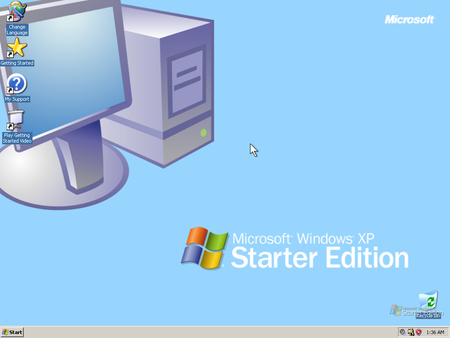If you are a digital old man, you may remember that until the year 2001, there was a certain harmony in the versions of Windows. With some exceptions, you should not worry about choosing a specific version of the operating system for your personal computer. If you wanted to install Windows ME, unless you worked in a company’s IT department and wanted to go with Windows 2000, your only option was Windows ME.
This changed substantially with the advent of Windows XP. Microsoft’s new operating system came with a lot of new features that promised to usher in a new era in computing history. But it also came with a good number of editions. So, you didn’t just have Windows XP anymore. In fact, this “dry” definition did not exist.
Windows and its multitude of editions
You had Windows XP Home, Windows XP Professional, Windows XP Media Center, Windows Starter, etc. This range of editions, to a greater or lesser extent, was also deployed in later versions, although some editions fell by the wayside. Starter editions appeared in Windows XP and came to an end in Windows 7, passing through the beloved and hated Windows Vista (which hasn’t been Microsoft’s worst system).
What led Redmond to release this latest edition, and why did it come to an end so soon after? Let’s go back in time to try to find out.
Starter editions, as we say, came to light with Windows XP, although its deployment was limited to some regions in the world and occurred several years after the initial release of the new operating system. According to Microsoft, it was “a low-cost introduction” to Windows XP specially designed for desktop computers in developing countries”.
Will Pole, Microsoft’s chief market expansion officer, remembered in 2006 that Windows XP Starter was born after a collaborative project with the Government of Thailand. The authorities hoped to distribute computers to families who could not afford them. “While working with the Thai government, we reconnected with Microsoft’s original vision of a PC on every desk and in every home,” recalled the executive.
Windows XP Starter
So Windows XP Starter, became available in thailand and also in other countries such as Argentina, Bolivia, Brazil, Chile, Colombia, Ecuador, the Philippines, Indonesia, India, Mexico, Malaysia, Peru, Russia, Turkey, Uruguay, Vietnam or Venezuela. And its features were very different from what was seen in any other edition of Windows.
The system, Microsoft explained, it allowed a maximum of three applications to run at the same time, its most ambitious resolution was 1024 x 768 pixels, and it lacked support for workgroup domains. Also, it was designed to work specifically with Intel Celeron or AMD Sempron processors. There were also other limits at the hardware level: it only supported 512 MB of RAM.
But it was not all cuts. Windows XP Starter also included a dedicated help page for anyone who was learning to use computers and videos with tutorials in the local language. In addition, it included custom backgrounds and screensavers. for some of the regions where it was available.
If you wanted to buy this edition of Windows, you just couldn’t. The reason? Microsoft did not sell licenses to users, but to manufacturers. In this sense, Windows XP Starter was included in some low-cost computers and was designed to work specifically there.

Windows Vista Starter
The arrival of Windows Vista did not mean the end of this edition of Windows. Microsoft returned to this formula with Windows Vista Starter. was also available in developing countries and maintained, to a large extent, the characteristics of its predecessor. However, the cuts were more substantial. For example, the new Windows Vista user interface, known as Windows Aero, was permanently disabled.

Windows 7 Starter
Later, with the introduction of Windows 7 came Windows 7 Starter. Here, as in previous editions, Microsoft wanted to limit the opening of programs to a maximum of three. The idea even advanced to development versions release candidate, but the company ended up backing down. Most of the limitations were still present, so it continued to establish itself as the most trimmed version of Windows in the catalog.
Since then we have not seen a Starter version of Windows. This may be because, although the hardware requirements of Microsoft’s operating systems have been increasing, we are at a point where even the low end hardware it is powerful enough to run them. And, on the other hand, it is no longer almost essential to have a computer.

That mission fulfilled by low-cost computers and later netbooks has been somewhat replaced by smartphones and tablets, proposals that do not use Microsoft operating systems, but Google’s. And there are also low-end devices. For these there are also less demanding editions of Android, such as Android Go.
Images: Microsoft | BlazePlastic2003
In Xataka: Pi is a chatbot that wants to compete with ChatGPT by being “nice”. And it’s already worth 4 billion dollars.














